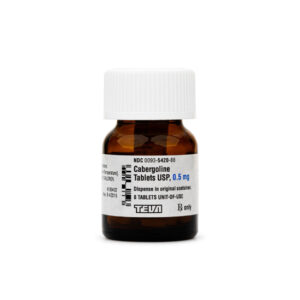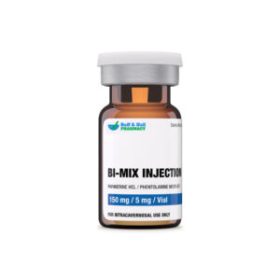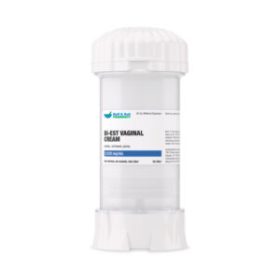Cabergoline Tablet (Each) †
† commercial produc
Either idiopathic or as a result of pituitary adenomas, cabergoline is a synthetic ergolinederived dopamine agonist that is indicated for the treatment of hyperprolactinemic diseases. Bromocriptine was the only drug authorized by the FDA for the management of hyperprolactinemias until 1996, when cabergoline came onto the market. Comparative investigations on the two drugs show that cabergoline more successfully inhibits prolactin secretion and offers a better tolerability profile than does bromocriptine. The special dosing plan of cabergoline is another possible benefit of the medication. While cabergoline has a long halflife and is prescribed once to twice weekly for hyperprolactinemia, bromocriptine requires many daily doses for effectiveness. Though there is evidence for the effectiveness of cabergoline in the therapy of restless legs syndrome, the drug is rarely used in clinical practice because of the risk of cardiac valvulopathy and the availability of safer alternatives.
A centrally-acting synthetic ergot alkaloid is cabergoline. Cabergoline suppresses prolactin levels in a dosedependent manner by dopamine agonist activity at dopamine2 (D2) receptors in the anterior pituitary. This area of the brain suppresses prolactin release by lactotrophs. Compared to other dopamine agonists like bromocriptine, cabergoline’s good tolerability profile may be explained by its relative selectivity. TSH, FSH, LH, ACTH, or GH. Loss of libido, amenorrhea, infertility, galactorrhea, gynecomastia, and impotence are among the symptoms that may be treated by the normalising of prolactin levels.
Cabergoline should not be used by people who are allergic to ergot-related substances or have heart valve problems. Before starting treatment, a heart checkup with an echocardiogram is necessary to ensure valves are healthy. If valve issues are present, cabergoline shouldn’t be prescribed. Patients should be monitored regularly, and the drug should be stopped if new heart problems develop. It’s also not recommended for individuals with lung, heart, or tissue scarring diseases, as it may worsen these conditions. Monitoring with blood tests and scans is important. People with uncontrolled high blood pressure should avoid cabergoline, as it may increase risks of strokes or seizures. Those with low blood pressure should use it carefully. Liver problems require close observation since cabergoline is processed by the liver. Some users may experience compulsive behaviors, such as gambling or increased sexual drive, which often improve after reducing or stopping the medicine. Pregnant women should avoid it unless absolutely needed, and breastfeeding mothers need to discuss risks with their doctor. Older adults should start with lower doses. Children’s safety hasn’t been studied, so it’s not recommended for them. Regular checkups and open communication with healthcare providers are essential throughout treatment.
In studies of cabergoline for hormone-related conditions, some side effects were more common compared to placebo or other treatments. Nausea, constipation, indigestion, and vomiting were reported, with nausea possibly linked to higher doses. Headaches, dizziness, and vertigo were also seen, sometimes leading to stopping treatment. Reproductive issues like breast pain and menstrual cramps occurred but were rare. Fatigue and general weakness were reported, along with mild flu-like symptoms and hot flashes. Blood pressure changes such as low pressure and fainting happened occasionally, especially with higher doses or when combined with other medications. Heart valve problems, lung scarring, and fluid buildup in the lungs were reported in some cases, particularly in patients taking high doses over long periods. Visual disturbances, nervousness, anxiety, and mood changes were noted, while skin issues like acne and itching, as well as muscle or joint pain, occurred rarely. Regular monitoring through heart scans, chest X-rays, and blood tests is important to catch problems early. Patients are advised to report symptoms like shortness of breath, chest pain, swelling, or mood changes right away, and treatment may need to be adjusted or stopped depending on the findings.
Current data suggests that cabergoline poses a low risk to the fetus in early pregnancy, but its effects with long-term use are still unknown. It’s generally not recommended for women with pregnancy-related high blood pressure, like preeclampsia or eclampsia, unless the benefits outweigh the risks. In postpartum women, cabergoline has been linked to high blood pressure, seizures, heart attacks, and strokes. In a study involving over 200 pregnancies, no increase in miscarriages, birth defects, abnormal birth weights, or growth issues was found compared to typical population rates. Exposure ranged from 1 to 144 days of pregnancy. Other studies also reported mostly healthy births, though some cases of miscarriage, molar pregnancy, and minor defects occurred. In one instance, a woman with Parkinson’s disease took cabergoline throughout two pregnancies without harming the babies, though a C-section was needed in one case. Patients should inform their doctor if they suspect or confirm pregnancy while on cabergoline. Because cabergoline can restore fertility in women with hyperprolactinemia, pregnancy testing is advised if pregnancy is suspected at any time during treatment.
Store this medication at 68°F to 77°F (20°C to 25°C) and away from heat, moisture and light. Keep all medicine out of the reach of children. Throw away any unused medicine after the beyond use date. Do not flush unused medications or pour down a sink or drain.
- Webster J, Piscitelli G, Polli A, et al. A comparison of cabergoline and bromocriptine in the treatment of hyperprolactinemic amenorrhea. N Engl J Med 1994;331:904-909.
- Dostinex (cabergoline) package insert. Kalamazoo, MI: Pharmacia and Upjohn Company; 2019 Dec.
- Aurora RN, Kristo DA, Bista SR, et al. The treatment of restless legs syndrome and periodic limb movement disorder in adults-an update for 2012: practice parameters with an evidence-based systematic review and meta-analyses: an American Academy
- Iller BM, Molitch ME, Vance ML, et al. Treatment of prolactin-secreting macroadenomas with the once-weekly dopamine agonist cabergoline. J Clin Endocrin Metabol 1996;81:2338-2343.
- Dostinex (cabergoline) package insert. Kalamazoo, MI: Pharmacia and Upjohn Company; 2019 Dec





